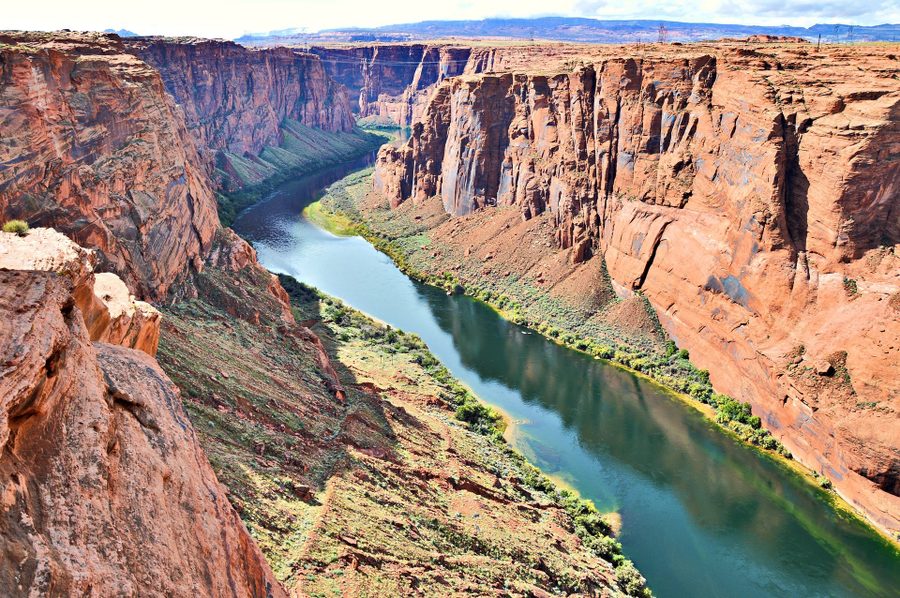Is the Walmart Family Capturing the Colorado River?
The Walton Family Foundation has been pouring millions into nonprofit groups concerned with the Colorado River — including media outlets that cover the issue.
Dave Marston Writers on the Range

If there’s a dominant force in the Colorado River Basin these days, it’s the Walton Family Foundation (WWF), flush with close to $5 billion to give away.
Run by the heirs of Walmart founder Sam Walton, the foundation donates $25 million a year to nonprofits concerned about the Colorado River. It’s clear the foundation cares deeply about the river in this time of excruciating drought, and some of its money goes to river restoration or more efficient irrigation.
Yet its main interest is promoting “demand management,” the water marketing scheme that seeks to add 500,000 acre-feet of water to declining Lake Powell by paying rural farmers to temporarily stop irrigating.
In November 2020, that focused involvement paid off. The Colorado Water Conservation Board boosted demand management into a “step two work plan,” moving the concept closer toward policy in the state, which leads the Upper Basin states of New Mexico, Wyoming and Utah in drought-management planning.
But is this approach, which verges on turning water into a commodity, good for the Colorado River? And was the public debate sufficient for policy about a water source that’s vital to 40 million people?
Without doubt, the foundation has supported the region’s nonprofits. During the last four years, over 60 Colorado River philanthropic organizations received between $5,000 and $2.9 million each, with seven organizations including the Environmental Defense Fund (EDF), The Nature Conservancy, and Western Resource Advocates each receiving $1 million or more in 2019 alone. A good share of the Walton Foundation’s $25 million in annual donations also went toward testing demand management on numerous creeks and tributaries in the Upper Basin states of Colorado, New Mexico and Wyoming.
The Walton Foundation also paid EDF millions to carry out crucial aspects of a $29 million pilot program for demand management in the Lower Basin states of Nevada, California and Arizona.
Then, there’s the Walton Foundation funding media to do stories about the Colorado River. What’s troubling is that some of the stories produced omit the Walton Foundation’s role in advocating for demand management.
Because the foundation’s reach is so extensive, few of its critics are willing to speak publicly. They charge that the Walton Family Foundation doesn’t just have a seat at the table, it sets the table’s agenda. Lately, though, some “water buffaloes” seem skittish about a policy that leads to water speculation, which raises the question: Are the critics of demand management gaining traction?
Dan Beard, former chief of the Bureau of Reclamation under President Clinton, hopes so.
“They (Walton Family Foundation) think they’ve found the solution,” he said “The way they’ve done that is to get all the nonprofits on their side. I think that’s a horrible result, especially for the environmental community. We need to sow the seeds of intellectual curiosity. If you’ve come to a conclusion and you don’t deviate from that, you’re nothing more than an intellectual dictator.”
Then, there’s the impact of Walton Foundation money on media nonprofits.
Brent Gardner-Smith runs Aspen Journalism, a nonprofit news organization that has received $100,000 annually for three years from the Walton Foundation and three years from the Catena Foundation, a foundation run by Sam Walton the 3rd. Public radio station KUNC has received three years of funding from the WFF for its “water desk.”
In May 2020, the two nonprofits collaborated in a story exploring the investment group Water Asset Management (WAM), speculating that it sought to “buy and dry” agricultural water, leaving behind barren dust bowls. What was not reported, that only municipalities can “buy and dry” under Colorado’s already tough water anti-speculation laws. The big omission was that a Walton-funded nonprofit, the Nature Conservancy, had an ongoing demand management study — exactly where and when WAM was buying land.
Colorado College journalism instructor Corey Hutchins said he was surprised to hear the size of some of the funding, with KUNC and Aspen Journalism each receiving $100,000 apiece for several years: “That sounds like a big Colorado water story in itself,” he said. “You might also worry about self-censorship.”
A story by Politico, a for-profit news conglomerate, is illustrative. In 2018, Politico received a $200,000 grant from the Walton Foundation for special projects. In December, Politico ran a feature on the drought-stricken Colorado River that quoted the Walton foundation’s head of Colorado River philanthropy, Ted Kowalski. Yet the foundation’s involvement in river policy wasn’t mentioned; nor was Politico’s previous funding from the Walton foundation noted.
Even odder, the recent New York Times article on water speculation in the Colorado River Basin omitted the Walton influence.
Joel Dyer, former editor for Boulder Weekly, who wrote a critical Walton piece, sees the issue of transparency this way: “They’ve (the Walton Family Foundation) spread their money so much they’ve diluted anyone who could push back. The big stories, the big ideas, who’s going to look into that?”
Dave Marston is the publisher of Writers on the Range, writersontherange.org, a nonprofit dedicated to spurring lively conversation about the West.





